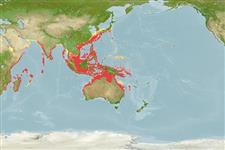Environment: milieu / climate zone / depth range / distribution range
Ecologia
marino demersale; distribuzione batimetrica 10 - 155 m (Ref. 9824). Tropical; 37°N - 32°S, 35°E - 160°E
Indo-West Pacific: definitely recorded from Inhambane, Mozambique; throughout the Indian Ocean to Java, Sumatra, Viet Nam, Philippines, Taiwan, South Korea, Japan, and Lord Howe Island (Ref. 9824).
Size / Peso / Age
Maturity: Lm ? range ? - ? cm
Max length : 27.0 cm TL maschio/sesso non determinato; (Ref. 9824)
Spine dorsali (totale) : 0; Raggi dorsali molli (totale) : 87 - 97; Spine anali: 0; Raggi anali molli: 61 - 73. Distinguished by cycloid scales on the ocular side, except for upper and lower margins of body, and a shorter lower jaw (2.3 to 2.9 times in head length). Body almost circular in shape in young, becoming ovate with growth.
Rare species (Ref. 9824). Found in sandy and muddy areas of the continental shelf (Ref. 5213). Feeds on benthic animals (Ref. 9824). Most sexually dimorphic characters develop at about 8 cm SL (Ref. 9824). Marketed fresh or used in making fish meal (Ref. 9824).
Life cycle and mating behavior
Maturità | Riproduzione | Deposizione | Uova | Fecundity | Larve
Hensley, D.A., 1986. Bothidae. p. 854-863. In M.M. Smith and P.C. Heemstra (eds.) Smiths' sea fishes. Springer-Verlag, Berlin. (Ref. 4417)
IUCN Red List Status (Ref. 130435: Version 2024-1)
Threat to humans
Harmless
Human uses
Pesca: commerciale
Strumenti
Special reports
Download XML
Fonti Internet
Estimates based on models
Preferred temperature (Ref.
123201): 22.1 - 28.4, mean 27.1 °C (based on 860 cells).
Phylogenetic diversity index (Ref.
82804): PD
50 = 0.5000 [Uniqueness, from 0.5 = low to 2.0 = high].
Bayesian length-weight: a=0.01047 (0.00446 - 0.02457), b=3.04 (2.86 - 3.22), in cm total length, based on LWR estimates for this Genus-body shape (Ref.
93245).
Trophic level (Ref.
69278): 3.5 ±0.37 se; based on food items.
Resilienza (Ref.
120179): Medio, tempo minimo di raddoppiamento della popolazione 1.4 - 4.4 anni (Preliminary K or Fecundity.).
Fishing Vulnerability (Ref.
59153): Low vulnerability (17 of 100).
Nutrients (Ref.
124155): Calcium = 156 [73, 273] mg/100g; Iron = 0.971 [0.473, 1.736] mg/100g; Protein = 17.3 [15.9, 18.7] %; Omega3 = 0.143 [0.068, 0.285] g/100g; Selenium = 59 [29, 128] μg/100g; VitaminA = 20.1 [5.8, 71.0] μg/100g; Zinc = 1.08 [0.71, 1.57] mg/100g (wet weight);
